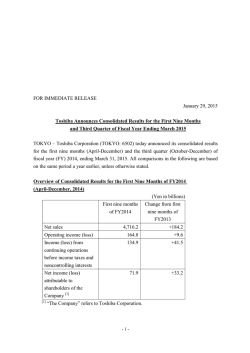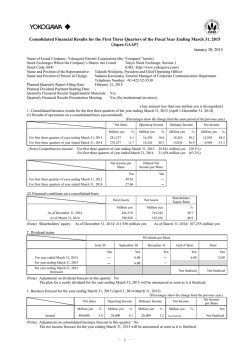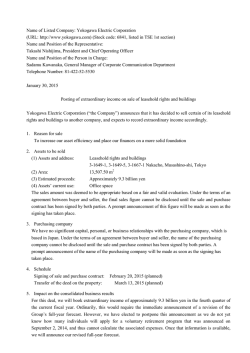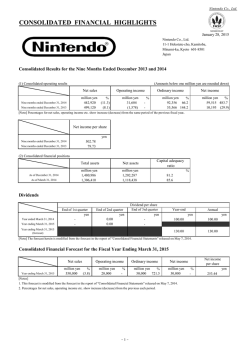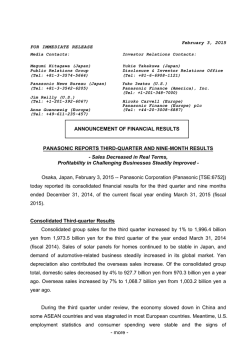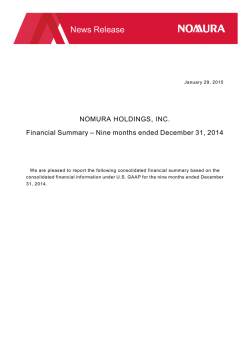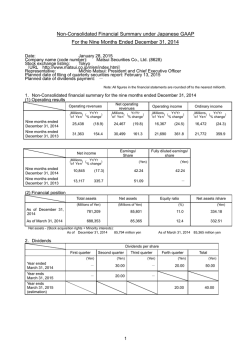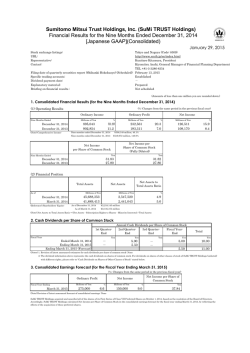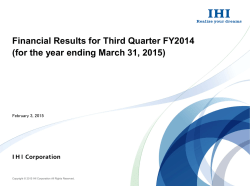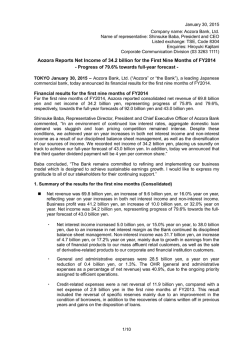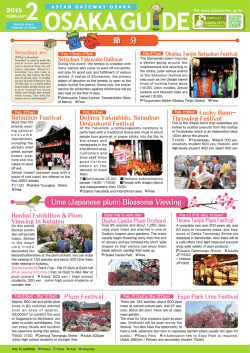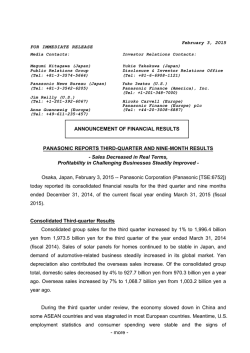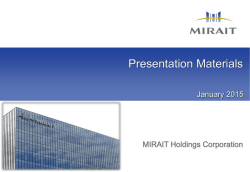
Consolidated Financial Statements Summary (For the nine
Consolidated Financial Statements Summary (For the nine months ended December 31, 2014) English translation from the original Japanese-language document (All financial information has been prepared in accordance with accounting principles generally accepted in Japan) : TEIJIN LIMITED (Stock code 3401) Company name Contact person : Masahiro Ikeda General Manager, IR section February 3, 2015 http://www.teijin.com TEL: +81-(0)3-3506-4395 (Amounts less than one million yen are omitted) 1. Highlight of the third quarter of FY2014 (April 1, 2014 through December 31, 2014) (1) Consolidated financial results (Percentages are year-on-year changes) Net sales Million yen % For the nine months ended December 31, 2014 578,450 0.0 For the nine months ended December 31, 2013 578,216 6.5 cf. Comprehensive income : (3,902) million yen (FY2013: 14,022 million yen) For the nine months ended December 31, 2014 For the nine months ended December 31, 2013 Operating income Ordinary income Million yen 24,568 9,678 Million yen 28,961 12,710 E.P.S.*1 Diluted E.P.S. Yen (14.68) 5.11 Yen ― 5.10 % 153.8 -4.6 Net income (loss) % 127.9 49.9 Million yen (14,424) 5,023 *1 E.P.S.: Earnings per share (2) Consolidated financial position Total assets Million yen As of December 31, 2014 832,691 As of March 31, 2014 768,411 cf. Shareholders' equity : 277,541 million yen (FY2013: 281,680 million yen) Net assets Shareholders' equity ratio Million yen 293,581 300,112 % 33.3 36.7 2. Dividends Dividends per share Period 1Q Yen ― ― FY2013 FY2014 FY2014 (Outlook) Note: Revision of outlook for dividends in the third quarter: No 2Q Yen 2.00 2.00 3Q Yen ― ― ― 4Q Yen 2.00 Annual Yen 4.00 2.00 4.00 3. Forecast for operating results in the year ending March 31, 2015 (Fiscal 2014) (Percentages are year-on-year changes) Net sales Operating income Ordinary income Net income E.P.S. Million yen Yen % Million yen % Million yen % Million yen % FY2014 780,000 -0.6 32,000 77.0 33,500 68.5 (18,000) ― (18.32) Note: Revision of outlook for fiscal 2014 consolidated operating results in the third quarter: Yes % ― 482.7 Appropriate Use of Forecasts and Other Information and Other Matters All forecasts in this document are based on management’s assumptions in light of information currently available and involve certain risks and uncertainties. Actual results to differ materially from these forecasts. For information on these forecasts, refer to "Qualitative Information on Outlook for Operating Results," beginning on page 7. 1. Qualitative Information and Financial Statements Qualitative Information on Results of Operations Analysis of Consolidated Results of Operations The global economy was comparatively stable in the nine months ended December 31, 2014, underpinned by an ongoing, self-sustaining recovery in the United States. Nonetheless, economic growth in the People’s Republic of China (PRC) slowed, reflecting a downturn in the country’s real estate market, while conditions in Russia and other resource-rich nations deteriorated from the third quarter, a consequence of plummeting crude oil prices, and key Eurozone economies, which are strongly influenced by trends in Russia, showed increasing signs of stagnation. Although the Japanese economy has benefited recently from lower crude oil prices and the depreciation of the yen, the pace of recovery from the slump that followed the 2014 consumption tax hike remained sluggish. Under these conditions, consolidated net sales remained essentially level, edging up ¥0.2 billion, to ¥578.5 billion, as sales were generally favorable in all segments, bolstered by the weak yen, which largely countered the impact of the discontinuation of in-house production and sales of paraxylene. Operating income soared 153.8%, or ¥14.9 billion, to ¥24.6 billion, supported by firm sales in our core strategic Advanced Fibers and Composites and Healthcare segments, as well as by restructuring initiatives in, among others, the Electronics Materials and Performance Polymer Products segment. Ordinary income climbed 127.9%, or ¥16.3 billion, to ¥29.0 billion, as the weaker yen boosted foreign exchange gains. Owing to extraordinary losses arising from restructuring and other initiatives, which amounted to ¥46.4 billion, we reported a net loss of ¥14.4 billion, compared with net income of ¥5.0 billion in the nine months ended December 31, 2013. Net loss per share was ¥14.68, compared with net income per share of ¥5.11 in the corresponding period of fiscal 2013. Business Segment Results Advanced Fibers and Composites Sales in the Advanced Fibers and Composites segment totaled ¥98.8 billion, while operating income was ¥7.8 billion. High-Performance Fibers Demand remained firm for automotive applications and expanded for infrastructure-related applications. Sales of Twaron para-aramid fibers were steady for automotive applications, including tires in Europe, and reinforcements for optical fibers, as well as for cables and hoses for oil drilling and other infrastructure-related applications. Sales for use in ballistic protection products showed signs of recovery, shored up by expanded demand in Asia and the Middle East. The profitability of Technora para-aramid fibers improved, reflecting brisk domestic sales for automotive applications and exports for infrastructure-related applications, as well as the weaker yen. Although sales of Teijinconex meta-aramid fibers for use in protective clothing and for industrial applications were solid, sales for use in filters were hampered by relentless competition, despite rising demand. In polyester fibers, income at our subsidiary in Thailand began to rise gradually—notwithstanding a negative rebound in local sales for automotive applications, which were robust in fiscal 2013—thanks to an increase in sales volume for use in personal hygiene and general-purpose products, as well as to falling prices for raw materials and the reduction –1– of costs. In Japan, sales volume for automotive applications slipped amid sagging demand, while a largely mild winter hindered sales of products used in bedding. Nonetheless, profitability was buttressed by higher sales for infrastructureand civil engineering-related applications and for use in reverse osmosis membranes for water treatment applications, as well as by efforts to cut costs. With the aim of further strengthening competitiveness, we took the decision to realign our domestic production configuration and transfer production of certain items to the aforementioned subsidiary in Thailand. Under these circumstances, we pressed forward with preparations to begin production of Teijinconex neo, a new type of meta-aramid fiber offering superior heat resistance and dyeability, in Thailand in July 2015. Motivated by increasingly stringent regulations pertaining to heat-resistant materials and environmental safety, we will focus on expanding this particular business in promising Asian markets and emerging economies. In the PRC, our polyester recycling joint venture in Zhejiang Province proceeded with the construction of a new production facility, which is scheduled to commence operations before the end of fiscal 2014. Carbon Fibers and Composites We posted firm sales overall and accelerated technological development. Sales of TENAX carbon fibers for use in aircraft remained favorable, as brisk orders for aircraft prompted an increase in production by leading aircraft manufacturers. Among general industrial applications, sales for use in pressure vessels remained steady, supported by the expansion of sales in North America for natural gas storage and sales in Asia for use in reinforcement materials for civil engineering-related applications and in sports and leisure equipment. The depreciation of the yen and declines in raw materials and fuel prices, particularly evident since autumn 2014, contributed to profitability. Against this backdrop, in the area of products for aircraft applications TENAX thermoplastic consolidated laminate (TPCL) was qualified for use in Airbus S.A.S.’ A350 XWB all-new, extra-wide body midsize jetliner and subsequently adopted for use in the A350 XWB family. On another front, we accelerated efforts to realize new technologies that will facilitate our evolution toward a business model focused on providing solutions that match the needs of customers and markets, promoting the development of new production technologies for thermoplastic carbon fiber-reinforced plastic (CFRP) and of rapid-curing and super-heat-resistant varieties of prepreg. We also pressed ahead with the development of structural components for mass-produced vehicles made with our innovative thermoplastic CFRP Sereebo. To this end, the Teijin Composites Innovation Center, situated within our Matsuyama Plant, which is in Ehime Prefecture, and the Teijin Composites Application Center, located in Metro Detroit, in the United States, are collaborating on multiple projects targeted at developing specific components and establishing mass-production procedures, and are making solid progress on both fronts. With our joint development work with General Motors Company entering the final stage of preparation for commercialization and Sereebo now officially registered on General Motors’ materials list, we began looking into the establishment of a new carbon fibers production facility in the United States. –2– Electronics Materials and Performance Polymer Products The Electronics Materials and Performance Polymer Products segment reported sales of ¥138.9 billion and an operating loss of ¥0.2 billion. Resin and Plastics Processing Profitability rallied, bolstered by a decline in prices for key raw materials and the positive impact of restructuring initiatives. From July 2014 onward, we sought to counter rising prices for principal raw materials by raising sales prices for mainstay polycarbonate resin products Panlite and Multilon. Thanks to a decline in prices for such materials and the positive impact of restructuring initiatives, margins on these products improved in the second half of October, as a result of which profitability rallied. Nonetheless, competition is expected to remain harsh over the medium term, owing to a glut of products in the market. Accordingly, we will step up strategic efforts to shift our emphasis from commoditized products to high-performance offerings. At the same time, we will work to further reinforce our earnings foundation by capitalizing on the halt of production at our plant in Singapore, scheduled for December 2015, to optimize production capacity and shrink fixed costs. Construction of a new polymer production facility by INITZ Co., Ltd., our polyphenylene sulfide (PPS) joint venture with SK Chemicals Ltd. of the Republic of Korea (ROK), remained on schedule as work proceeded apace. INITZ is currently marketing products, with commercial production slated to begin in autumn 2015. In processed plastics, sales of transparent electroconductive polycarbonate film for use in capacitive touch screens for vehicle navigation systems—a central focus in this business—continued to expand smoothly. We stepped up efforts to market retardation film for use as antireflective film on smartphones, among others, that leverages the unique optical properties of polycarbonate, as well as expanded our focus to include wearable devices. Among high-performance resins, sales of specialty polycarbonate resin for use in smartphone camera lenses were steady. We also promoted the expansion of applications for polyethylene naphthalate (PEN) resin that maximize PEN’s outstanding transparency and chemical resistance gas barrier properties, taking advantage of the start of full-scale sales for use in the world’s first fire extinguishers with plastic cylinders. Films Sales of products for use in smartphones and other devices were solid, but products for other mainstay applications struggled. In the area of films for use as reflective film for liquid crystal display (LCD) televisions, the emergence of manufacturers from the PRC intensified pricing competition, while market conditions for PEN film for use in magnetic materials remained harsh, a consequence of flagging demand. In contrast, sales of PUREX release films for manufacturing processes remained firm for use in multilayer ceramic capacitors and polarizers for smartphones and other devices. Having recognized that further enhancing production efficiency is essential to securing profitability going forward, we resolved to integrate polyester film production, currently divided between our Gifu and Utsunomiya factories, at the latter facility. Production at the Gifu Factory will be scaled back gradually, with operations at the facility scheduled to conclude at the end of September 2016. We also focused development efforts on other high-performance films that will support the growth and evolution of this business in the years ahead. Overseas, demand for packaging and general industrial applications and for use in solar cells flagged in the United Stated –3– and Europe. Nonetheless, we sought to secure profitability by reducing costs. Profitability in the PRC remained encouraging, sustained by steady demand. Healthcare Sales in the Healthcare segment came to ¥105.9 billion, while operating income was ¥21.3 billion. Pharmaceuticals Sales of our novel treatment for hyperuricemia and gout expanded favorably. Operating conditions for our domestic pharmaceuticals business remained harsh, owing to the April 2014 revision of reimbursement prices for prescription pharmaceuticals under Japan’s National Health Insurance (NHI) scheme and to rising sales of generic drugs following adjustments to fees for medical services. Nonetheless, sales of hyperuricemia and gout treatment Feburic (febuxostat) expanded favorably, further boosting our leading share of the Japanese market for such treatments. Sales of osteoporosis treatment Bonalon®* rose, reflecting the introduction of new formulations—notably an intravenous drip and an oral jelly, both firsts for Japan—that broadened choices available to osteoporosis sufferers. Sales of Somatuline®†, a treatment for acromegaly launched in January 2013, were also encouraging. Sales of febuxostat also continued to expand encouragingly overseas. We have secured exclusive distributorship agreements for febuxostat covering 117 countries and territories. The drug is currently sold in 41 of these countries and territories, and we are in the process of obtaining regulatory approval to make it available in the others. In R&D, we signed an agreement in May 2014 with U.K. pharmaceuticals manufacturer Sigma-Tau Pharma Ltd., gaining exclusive development and distribution rights in Japan for EZN-2279, a therapeutic agent for adenosine deaminase (ADA) deficiency developed by Sigma-Tau, and began preparing for domestic clinical trials. We also proceeded with the development of KTF-374, an innovative sheet-type fibrin surgical sealant that integrates pharmaceuticals and materials technologies, while core segment subsidiary Teijin Pharma Limited and Kaketsuken (The Chemo-Sero-Therapeutic Research Institute) prepared for the start of clinical trials in Japan. In line with this, in October 2014 we initiated construction of a new integrated pharmaceuticals development laboratory, to be named the Technology Integrated Pharmaceutics Center, in Iwakuni, Yamaguchi Prefecture. In June 2014, we commenced clinical trials in Japan for TMX-67XR (Feburic Tablet) (febuxostat), a new formulation with a revised dosage volume, while in December 2014 we embarked on Phase II clinical trials for bronchial asthma treatment PTR-36. Home Healthcare Rental volumes remained high or increased. We currently provide home healthcare services to more than 400,000 individuals in Japan and overseas. In Japan, rental volume for mainstay therapeutic oxygen concentrators for home oxygen therapy (HOT) remained firm, thanks to the release of new models Hi-Sanso 3S and Hi-Sanso Portable α (alpha). In June 2014, we launched Hi-Sanso 5S * † Bonalon® is the registered trademark of Merck Sharp & Dohme Corp., Whitehouse Station, NJ, U.S.A. Somatuline® is a registered trademark of Ipsen Pharma S.A.S., Paris, France. –4– and Sanso Saver 5, a new unit that helps resolve concerns and inconvenience for HOT patients in the event of a disaster or a major power failure. Rental volume for continuous positive airway pressure (CPAP) ventilators for the treatment of sleep apnea syndrome (SAS) continued to increase encouragingly, augmented by the launch of NemLink, a monitoring system for CPAP ventilators that uses mobile phone networks and which also provides pertinent data to medical care facilities to enhance the effectiveness of treatment. Rentals of our noninvasive positive pressure ventilators (NPPVs) (the NIP NASAL series and AutoSet CS) also rose encouragingly. To fortify support services for individuals, we sought to improve our ability to respond to patient needs by capitalizing on new home healthcare call centers in Fukuoka and Osaka, the latter established in fiscal 2013. We are also gradually expanding marketing of the WalkAide System, a neuromuscular electrical stimulation device for the treatment of gait impairment resulting from stroke and other causes launched in fiscal 2013, which initially focused on the Tokyo metropolitan area, to medical institutions in other areas of the country. Overseas, we currently provide home healthcare services in the United States, Spain and the ROK. In the period under review, operating conditions in the United States remained harsh, a consequence of healthcare system reform and sizeable ensuing declines in medical treatment fees, as well as other factors. We responded by taking steps to restore profitability, including integrating sales bases and reducing headcount. Trading and Retail The Trading and Retail segment yielded sales of ¥190.5 billion and operating income of ¥3.2 billion. Fiber Materials and Apparel Efforts focused on expanding strategic collaboration with leading overseas sportswear manufacturers. In fiber materials and apparel, sales of products for use in sportswear and outdoor apparel were healthy, bolstered by efforts to reinforce brand deployment for high-performance materials. Of particular note, sales of the DELTAPEAK series, which we have positioned as a core global brand, expanded dramatically thanks to strategic efforts to develop products in collaboration with leading overseas sportswear manufacturers. In the fibers and yarn sales business, sales price hikes for imported yarns could not keep pace with the rapid weakening of the yen. The uniforms business also struggled, as an increase in cost of sales hampered margins. In textiles and apparel, the weaker yen and rising overseas sewing costs combined to squeeze the profitability of our mainstay OEM business, while sales of both summer and autumn/winter apparel were hampered by unseasonable weather, which depressed results during peak sales periods. Against this backdrop, we pushed ahead with efforts to establish a solid network of sewing bases, focusing on Vietnam and Myanmar, with the aim of augmenting our supply capabilities in the Association of Southeast Asian Nations (ASEAN) region. In a move designed to strengthen our sales capabilities, we fortified our original design manufacturer (ODM) business by maximizing our materials development capabilities. Efforts included proposing innovative compound materials made with SOLOTEX polytrimethylene terephthalate (PTT) fibers, a strategically important product. –5– Industrial Textiles and Materials Sales of products for environmental and safety-related applications were brisk. In industrial fabrics, sales of materials for use in tire cords and other automotive applications were firm overall, although profitability of imported products deteriorated as a consequence of the yen’s sharp downturn. Expanding our operations overseas, in June 2014 we established a new tire cord production joint venture in Thailand, the operations of which will encompass twisting, weaving and adhesive treatment. The new company is expected to commence operations in October 2015. Also in June, we began building a new processing line for automotive hose cords at subsidiary Teijin Cord (Thailand) Co., Ltd. This will position us to accelerate sales of rubber materials for automotive applications to the Asian automobile industry, which is expected to continue expanding in the years ahead. Among general-purpose materials, tents rebounded negatively after a robust first half, entering an inventory adjustment phase. Shipments of nonwoven fabrics, materials for civil engineering-related applications and carbon materials for use in sports equipment remained steady. In the area of materials for environmental applications, sales of filters for use in wastewater processing in the PRC expanded. In interior materials, sales of home-use wiping cloths and related products were solid, but sales of curtains and wall- and floor-covering materials were generally weak. Others Others, which does not qualify as a reportable operating segment, generated sales of ¥44.3 billion and operating income of ¥1.4 billion. In the IT business, the favorable expansion of sales from the distribution of e-books contributed to firm sales in the net services category. In the IT services category, we established EverySense, Inc., in partnership with two other companies, with the aim of developing and offering new services in the Internet of Things (IoT)‡ market, and continued to provide mental health support services for corporate employees on overseas assignment. Another highlight in this category was the launch of Digital Health Connect, Japan’s first IT tool designed to facilitate collaboration among innovators in the healthcare field. In new business development, we installed a second line at our production facility in the ROK for LIELSORT lithium-ion battery (LiB) separators, which are rapidly becoming the separator of choice for leading battery manufacturers, with the aim of further expanding this business. The new line, which began operating in December 2014, has doubled our LIELSORT production capacity, thereby positioning us to respond to expanding demand, as well as to accommodate production of a new LIELSORT product currently under development. In the area of advanced medical materials, efforts to promote the commercialization of innovative products received a boost when our project to develop a patch for cardiac repair was selected for support under a program launched by Japan’s Ministry of Economy, Trade and Industry to promote collaboration between medical institutions and industry, making it possible for us to continue joint development with Osaka Medical College and Fukui Warp Knitting Co., Ltd. The purpose of the project is to develop a groundbreaking patch to replace damaged cardiac tissue that achieves both the strength and extensibility required for long-term use. On another front, we stepped up efforts to market NanoGram ‡ The IoT is a concept that describes the interconnection of a vast array of devices worldwide via the Internet. Such advanced connectivity will facilitate the realization of a wide range of new services. –6– silicon paste—developed for use in the production of high conversion-efficiency solar cells as a solution that further enhances cell efficiency—to solar cell manufacturers. We are currently providing samples to customers for evaluation. Qualitative Information on Financial Position Analysis of Assets, Liabilities, Net Assets and Cash Flows Assets, Liabilities and Net Assets Despite a decline in fixed assets attributable to the application of impairment accounting, total assets as of December 31, 2014, amounted to ¥832.7 billion, up ¥64.3 billion from the end of fiscal 2013. This was primarily due to an increase in the yen value of assets denominated in foreign currencies and higher stock purchases, which pushed up investment securities. Total liabilities, at ¥539.1 billion, were up ¥70.8 billion from the fiscal 2013 year-end. Interest-bearing debt rose ¥35.8 billion, to ¥317.3 billion, with contributing factors including the issue of bonds with stock acquisition rights. Total net assets decreased ¥6.5 billion, to ¥293.6 billion. Notwithstanding increases attributable to valuation difference on available-for-sale securities and foreign currency translation adjustments, total shareholders’ equity and total valuation and translation adjustments, which together represented ¥277.5 billion of total net assets, fell ¥4.1 billion, owing to the net loss reported for the period and the payment of dividends. Qualitative Information on Outlook for Operating Results Outlook for Fiscal 2014 Forecast for Operating Results (Billions of yen/%) Net sales Fiscal 2014 (Forecast) Fiscal 2013 Change Percentage change Operating income Ordinary income Net income (loss) ¥780.0 ¥32.0 ¥33.5 ¥(18.0) 784.4 18.1 19.9 8.4 –4.4 +13.9 +13.6 –26.4 –0.6% +77.0% +68.5% — The global economic outlook remains fraught with uncertainties as crude oil prices continue to tumble and the direction –7– of monetary policy in many countries is unclear. Owing to yen depreciation and falling prices for raw materials and fuel, among others, results in our materials businesses remain firm. For this and other reasons, we have revised our full-term forecasts, with the exception of that for consolidated net sales, which remains at ¥780.0 billion. We now expect to report consolidated operating income of ¥32.0 billion, ordinary income of ¥33.5 billion and a net loss of ¥18.0 billion, all of which represent improvements from our previous forecasts, announced in November 2014, which were for operating income of ¥25.0 billion, ordinary income of ¥23.5 billion and a net loss of ¥20.0 billion. These forecasts assume exchange rates of ¥110 to US$1.00 and ¥138 to €1.00 and an average Dubai crude oil price of US$83 per barrel. In light of changes in our operating environment since the formulation of our CHANGE for 2016 medium- to long-term management vision in 2012, in November 2014 we announced a revised version of the vision’s medium-term management plan that emphasizes two priorities, namely, restructuring initiatives and transformation and growth strategies. The goals of restructuring initiatives are to restore profitability and establish a foundation for future growth by concentrating management resources in promising businesses and realigning our production configurations. Transformation and growth strategies emphasize building a new business model that integrates key capabilities from three existing core businesses—high-performance materials, healthcare and IT—with the aim of actively fostering profitable new businesses. Forecast for Segment Results for Fiscal 2014 (Billions of yen) Net sales Operating income (loss) Full term Full term 1Q–3Q 1Q–3Q (Forecast) (Forecast) ¥ 98.8 ¥140.0 ¥ 7.8 ¥ 11.5 Advanced Fibers and Composites Electronics Materials and Performance Polymer Products 138.9 180.0 (0.2) 0.0 Healthcare 105.9 140.0 21.3 25.0 Trading and Retail 190.5 255.0 3.2 4.5 Total 534.1 715.0 32.1 41.0 44.3 65.0 1.4 3.5 — — (8.9) (12.5) ¥578.5 ¥780.0 ¥24.6 ¥ 32.0 Others Elimination and corporate Consolidated total –8– 2. Other Information Changes in significant subsidiaries during the period under review: None Adoption of special quarterly accounting methods: Certain of the Company’s consolidated subsidiaries have adopted a method for estimating in practical terms the effective tax rate for the fiscal year, including for the nine months ended December 31, 2014, following the application of tax effect accounting to income before income taxes, and multiplying this by quarterly income before income taxes to estimate quarterly tax expense. Changes in accounting principles, procedures and presentation methods: Application of Accounting Standard for Retirement Benefits Effective from the three months ended June 30, 2014, the Company has applied the accounting rules stipulated in Clause 35 of the “Accounting Standard for Retirement Benefits” (Accounting Standards Board of Japan (ASBJ) Statement No. 26, issued on May 17, 2012) and the guidelines outlined in Clause 67 of the “Guidance on Accounting Standard for Retirement Benefits” (ASBJ Guidance No. 25, issued on May 17, 2012). Accordingly, the method of attributing expected benefits to periods has been changed from the straight-line basis to the benefit formula basis and the basis for determining the discount rate has been amended from the expected average remaining working lives of employees and average period up to the estimated timing of benefit payment to a single weighted-average discount rate that reflects the estimated timing and amount of benefit payment. The application of the new accounting standard and its accompanying guidance is subject to the transitional accounting treatment set forth in Clause 37 of the standard. At the beginning of the period under review—the nine months ended December 31, 2014—remeasurements of defined benefit plans were included in retained earnings to reflect the impact of this change in method of accounting. This change added ¥574 million to the “other” component of investments and other assets, reduced net defined benefit liability by ¥1,589 million and increased retained earnings by ¥1,465 million in the period. The effect of this change on operating, ordinary and net income and losses was negligible. The effect of this change on segment information was also negligible and has thus not been reported. Change in accounting estimate In the first half of fiscal 2014, the Company resolved to withdraw from the business of consolidated subsidiary Teijin Polycarbonate Singapore Pte Ltd. As a consequence, the expected remaining contract term for real estate leased by the company was shortened to a more practical number of years, thus facilitating a more precise estimate of asset retirement obligations—namely, an obligation of restoration to original condition—associated therewith. Owing to the revision of this estimate, the balance of asset retirement obligations as of December 31, 2014, was ¥9,044 million higher than would have been the case had the estimate not changed. In addition, because the Company applied impairment accounting to the accompanying tangible fixed assets, the effect of this change in accounting estimate was to increase loss before income taxes in the nine months ended December 31, 2014, by ¥9,044 million. Italicized product names and service names in this report are trademarks or registered trademarks of the Teijin Group in Japan and/or other countries. Where noted, other italicized product names and service names used in this document are protected as the trademarks and/or trade names of other companies. –9– 3. Financial Statements (1) Consolidated Balance Sheets As of March 31, 2014 (Millions of yen) As of December 31, 2014 < Assets > Current assets Cash and deposits Notes and accounts receivable-trade Finished goods Work in process Raw materials and supplies Other current assets Allowance for doubtful receivables Total 33,134 165,239 79,014 9,084 30,569 50,553 (2,687) 364,908 43,191 182,550 88,282 9,675 30,345 61,353 (2,345) 413,052 Fixed assets Tangible assets Buildings and structures, net Machinery and equipment, net Other, net Total 69,238 91,429 76,193 236,861 62,690 76,999 78,802 218,492 Total 15,806 13,651 29,457 9,908 11,788 21,697 Investments and other assets Investment securities Other Allowance for doubtful accounts Total Total fixed assets 82,068 58,201 (3,085) 137,184 403,502 111,418 71,262 (3,231) 179,449 419,638 768,411 832,691 Intangible assets Goodwill Other Total assets – 10 – As of March 31, 2014 < Liabilities > Current liabilities Notes and accounts payable-trade Short-term loans payable Current portion of long-term loans payable Current portion of bonds Income taxes payable Other Total Non-current liabilities Bonds payable Long-term loans payable Provision for business structure improvement Provision for retirement benefits Asset retirement obligations Other Total Total liabilities <Net assets> Shareholders' equity Capital stock Capital surplus Retained earnings Treasury stock Total (Millions of yen) As of December 31, 2014 80,003 84,604 21,811 6,960 2,915 52,367 248,662 90,573 73,082 5,789 19,038 6,214 56,210 250,908 30,000 136,401 — 30,204 1,245 21,784 219,635 468,298 55,197 162,617 11,941 29,730 11,266 17,448 288,202 539,110 70,816 101,429 111,754 (435) 283,564 70,816 101,431 94,863 (448) 266,661 Valuation and translation adjustments Valuation difference on available-for-sale securities Deferred gains on hedges Foreign currency translation adjustment Remeasurements of defined benefit plans Total 10,758 1,017 (13,025) (634) (1,884) 15,768 89 (3,839) (1,138) 10,879 Subscription rights to shares Minority interests Total net assets Total liabilities and net assets 737 17,694 300,112 768,411 750 15,288 293,581 832,691 – 11 – (2) Consolidated Statements of Income (Millions of yen) For the nine months ended December 31, 2013 Net sales Cost of sales Gross profit Selling, general and administrative expenses Operating income Nonoperating revenues Interest income Dividends income Equity in earnings of affiliates Foreign exchange gains Gain on valuation of derivatives Miscellaneous income Total Nonoperating expenses Interest expenses Foreign exchange losses Miscellaneous loss Total Ordinary income Extraordinary income Gain on sales of noncurrent assets Gain on sales of investment securities Reversal of impairment losses Other Total Extraordinary loss Loss on sales and retirement of noncurrent assets Loss on valuation of investment securities Impairment loss Business structure improvement expenses Other Total Income (loss) before income taxes Income taxes Income (loss) before minority interests Minority interests in loss Net income (loss) – 12 – For the nine months ended December 31, 2014 578,216 437,367 140,849 131,170 9,678 578,450 424,170 154,279 129,711 24,568 379 805 3,649 — 1,897 1,113 7,845 455 1,279 2,511 812 2,758 676 8,494 2,589 188 2,036 4,814 12,710 2,243 — 1,857 4,101 28,961 178 8,166 — 461 8,806 70 67 77 25 241 865 83 6,417 1,750 1,286 10,403 11,113 8,046 3,066 (1,956) 5,023 511 0 31,563 13,915 363 46,353 (17,150) (391) (16,759) (2,334) (14,424) (Consolidated Statements of Comprehensive Income) (Millions of yen) For the nine months ended December 31, 2013 Income (loss) before minority interests Other comprehensive income Valuation difference on available-for-sale securities Deferred gains (losses) on hedges Foreign currency translation adjustment Remeasurements of defined benefit plans, net of tax Share of other comprehensive income of associates accounted for using the equity method Total Comprehensive income (loss) Comprehensive income attributable to Comprehensive income (loss) attributable to owners of the parent Comprehensive loss attributable to minority interests – 13 – For the nine months ended December 31, 2014 3,066 (16,759) (872) 691 10,175 — 5,008 (929) 8,074 (542) 961 1,245 10,955 14,022 12,856 (3,902) 15,989 (1,966) (1,661) (2,241) (3) Notes Pertaining to Going Concern Assumption No (4) Notes on Significant Changes in Shareholders' Equity No (5) Segment Information, etc. I. Outline of segments The Company's reportable operating segments are components of an entity for which separate financial information is available and evaluated regularly by its chief decision-making authority in determining the allocation of management resources and in assessing performance. The Company currently divides its operations into business groups, based on type of product, nature of business and services provided. The business groups formulate product and service strategies in a comprehensive manner in Japan and overseas. Accordingly, the Company divides its operations into four reportable operating segments on the same basis as it uses internally: Advanced Fibers and Composites (comprising High-Performance Fibers and Carbon Fibers and Composites); Electronics Materials and Performance Polymer Products (comprising Polycarbonate Resin and Plastics Processing, and Films); Healthcare; and Trading and Retail. Within the Advanced Fibers and Composites segment, the High-Performance Fibers business encompasses the production and sale of advanced aramid fibers and polyester fibers for industrial applications, and the Carbon Fibers and Composites business includes the production and sales of carbon fibers and composites. Within the Electronics Materials and Performance Polymer Products segment, the Polycarbonate Resin and Plastics Processing business involves the production and sale of polycarbonate resin, other resins and resin products, while the Films business includes the production and sales of polyester films. Healthcare encompasses the production and sales of pharmaceuticals, the production and rental of home healthcare devices and the provision of home healthcare services. Trading and Retail focuses on the planning, OEM production and trading and retail of polyester filaments, other fibers and polymer products. II. FY13 3Q results (Apr. 2013 – Dec. 2013) 1. Segment sales and operating income (loss) (Millions of yen) Reportable operating segments Advanced Fibers and Composites Electronics Materials and Performance Polymer Products Healthcare Trading and Retail Subtotal Others* Total Sales 1) External customers 88,754 136,274 101,392 186,892 513,314 64,901 578,216 2) Intersegment transactions or transfers 20,229 3,855 — 3,225 27,310 17,003 44,313 Net sales 108,984 140,130 101,392 190,118 540,625 81,904 622,529 Segment income (loss) 3,303 (4,502) 17,330 3,447 19,579 (868) 18,711 * "Others," which includes the polyester raw materials and polymerization business and the IT business, does not qualify as a reportable operating segment. 2. Difference between operating income and sum of operating income (loss) in reportable operating segments (Adjustment) (Millions of yen) Operating income (loss) Amount Total reportable operating segments 19,579 Others segment (868) Elimination of intersegment transactions 182 Corporate expenses* (9,214) Operating income 9,678 * Corporate expenses are expenses that cannot be allocated to individual reportable operating segments and are primarily related to basic research and head office administration. – 14 – 3. Loss Loss on on impairment impairment and and goodwill goodwill by by reportable reportable operating segmentssegments Material loss on impairment of fixed assets In the nine months ended December 31, 2013, the Electronics Materials and Performance Polymer Products and Others segments reported losses on impairment of ¥5,448 million and ¥966 million, respectively. Material change in the amount of goodwill and material gain from negative goodwill No III.FY14 3Q results (Apr. 2014 – Dec. 2014) 1. Segment sales and operating income (loss) (Millions of yen) Reportable operating segments Advanced Fibers and Composites Electronics Materials and Performance Polymer Products Healthcare Trading and Retail Subtotal Others* Total Sales 1) External customers 98,785 138,932 105,867 190,528 534,114 44,335 578,450 2) Intersegment transactions or transfers 20,631 3,419 — 3,691 27,742 15,245 42,987 Net sales 119,417 142,352 105,867 194,219 561,856 59,581 621,437 Segment income (loss) 7,847 (239) 21,279 3,197 32,083 1,389 33,472 * "Others," which includes the polyester raw materials and polymerization business and the IT business, does not qualify as a reportable operating segment. 2. Difference between operating income and sum of operating income (loss) in reportable operating segments (Adjustment) (Millions of yen) Operating income (loss) Amount Total reportable operating segments 32,083 Others segment 1,389 Elimination of intersegment transactions (199) Corporate expenses* (8,704) Operating income 24,568 * Corporate expenses are expenses that cannot be allocated to individual reportable operating segments and are primarily related to basic research and head office administration. 3.Changes to reportable operating segments Material loss on impairment of fixed assets In the nine months ended December 31, 2014, the Advanced Fibers and Composites, Electronics Materials and Performance Polymer Products, Healthcare and Others segments reported losses on impairment of \1,199 million, \19,953 million, \4,366 million and \5,997million, respectively. Material change in the amount of goodwill In the nine months ended December 31, 2014, the Company reported impairment losses in the Electronics Materials and Performance Polymers Products andHealthcare segments, resulting in a material change in the amount of goodwill. As a consequence, goodwill in the Electronics Materials and Polymer Products and Healthcare segments declined \1,543 million and \3,418 million respectively. Impairment losses on goodwill are included in the figures presented above in "material loss on impairment of fixed assets." Material gain from negative goodwill No – 15 – Supplementary Information 1. Movement of consolidated results (1) Movement of results (Billions of yen) Net sales Operating income Ordinary income Net income (loss) FY2013 1Q 183.5 1.8 1.6 0.2 FY2013 2Q 198.3 3.4 2.5 4.3 FY2013 3Q 196.4 4.5 8.6 0.4 FY2013 4Q 206.2 8.4 7.2 3.3 FY2014 1Q 181.9 4.8 4.7 1.6 FY2014 2Q 195.5 7.3 9.4 (24.0) FY2014 3Q 201.1 12.4 14.9 7.9 (2) Movement of industrial segment information (Billions of yen) FY2013 1Q Net sales Advanced Fibers and Composites Electronics Materials and Performance Polymer Products Healthcare Trading and Retail Total Others Consolidated total Operating income (loss) Advanced Fibers and Composites Electronics Materials and Performance Polymer Products Healthcare Trading and Retail Total Others Elimination & corporate Consolidated total FY2013 2Q FY2013 3Q FY2013 4Q FY2014 1Q FY2014 2Q FY2014 3Q 28.2 30.2 30.4 34.8 31.4 33.0 34.4 44.3 47.0 44.9 43.2 46.2 46.0 46.7 31.5 57.1 161.1 22.4 183.5 33.3 63.8 174.4 23.9 198.3 36.6 66.0 177.9 18.6 196.4 37.0 67.3 182.3 23.9 206.2 33.2 57.5 168.4 13.5 181.9 34.5 66.1 179.6 15.9 195.5 38.1 66.9 186.1 14.9 201.1 0.2 2.2 0.9 2.4 1.7 3.0 3.2 (0.2) (2.4) (1.8) (2.7) 0.7 (2.1) 1.1 4.6 0.6 5.2 (0.0) (3.3) 1.8 4.8 1.8 6.3 (0.3) (2.6) 3.4 8.0 1.1 8.2 (0.5) (3.1) 4.5 7.2 1.7 8.7 2.6 (2.9) 8.4 5.7 0.8 8.8 (0.7) (3.3) 4.8 6.4 1.2 8.6 1.2 (2.5) 7.3 9.2 1.2 14.7 0.9 (3.1) 12.4 2. Capital expenditure, depreciation & amortization expenses and research & development expenses (consolidated) (Billions of yen) FY2011 FY2012 (Actual) (Actual) Capital expenditure: 32.3 36.3 CAPEX for tangible assets 28.3 33.1 Depreciation & amortization* 52.3 46.9 Research & development 31.8 33.2 * Depreciation and amortization includes amortization of goodwill. FY2013 FY2014 1Q–3Q (Actual) (Actual) 30.2 20.0 27.7 18.3 45.7 32.5 32.2 23.0 – 16 – FY2014 (Outlook) 34.0 30.7 44.0 33.0 3. Foreign Exchange Rate (1) BS exchange rate for overseas subsidiaries (End of fiscal year) FY2012 FY2013 (Actual) (Actual) JPY/US$ 94 US$/EUR 1.28 (2) PL exchange rate for overseas subsidiaries (Average of fiscal year) FY2012 FY2013 (Actual) (Actual) JPY/US$ 83 US$/EUR 1.29 FY2014 3Q (Actual) 103 1.38 FY2014 (Outlook) 121 1.22 FY2014 3Q (Actual) 100 1.34 118 1.13 FY2014 (Outlook) 107 1.31 110 1.26 4. Sales of principal pharmaceuticals Products FY2012 (Actual) Indication Bonalon ® Feburic ® Venilon ® Mucosolvan ® Onealfa ® Laxoberon ® Tricor ® Bonalfa ® Alvesco ® Osteoporosis Hyperuricemia and gout Severe infectious diseases Expectorant Osteoporosis Laxative Hyperlipidemia Psoriasis Asthma Somatuline ® Acromegaly and pituitary gigantism FY2013 (Actual) 15.9 5.5 9.9 9.0 7.9 4.0 1.8 1.4 1.3 14.2 11.4 9.4 7.9 6.6 3.6 1.7 1.3 1.3 0.1 0.6 (Billions of yen) FY2014 3Q (Actual) 9.9 11.4 7.7 5.0 4.2 2.3 1.3 0.9 0.9 0.8 5. Development status of new pharmaceuticals (As of December 31, 2014) Products NA872ET (Mucosolvan ® ) GGS-ON (Venilon ® ) GGS -MPA (Venilon ® ) GGS -CIDP (Venilon ® ) TMX-67TLS (Feburic ® ) TMX-67 ITM-014N (Somatuline ® ) ITM-058 PTR-36 KTP-001 TMX-67XR (Feburic ® ) TMG-123 Indication Stage Expectorant Filed in Japan in February 2014 Optic neuritis Ph III Microscopic polyangitis Ph III Chronic inflammatory demyelinating polyneuropathy Ph III Tumor lysis syndrome Ph III Hyperuricemia and gout Ph III (PRC) Neuroendocrine tumor Ph II Osteoporosis Ph II Bronchial asthma Ph II Lumbar disc herniation Ph I / II (US) Hyperuricemia and gout Ph I / II TypeII Diabetes Ph I * Bonalon ® is the registered trademark of Merck Sharp & Dohme Corp., Whitehouse Station, NJ, USA. * Somatuline ® is the registered trademark of Ipsen Pharma, Paris, France. * KTP-001 was discovered and is under development by Teijin Pharma Limited and Kaketsuken (The Chemo-Sero-Therapeutic ResearchInstitute), a general incorporated foundation, based on an enzyme engineered by Professor Hirotaka Haro of the University ofYamanashi’s Graduate School of Medicine and Engineering Advanced Medical Science and Dr. Hiromichi Komori, assistant head of theDepartment of Orthopaedic Surgery at Yokohama City Minato Red Cross Hospital. – 17 –
© Copyright 2024
